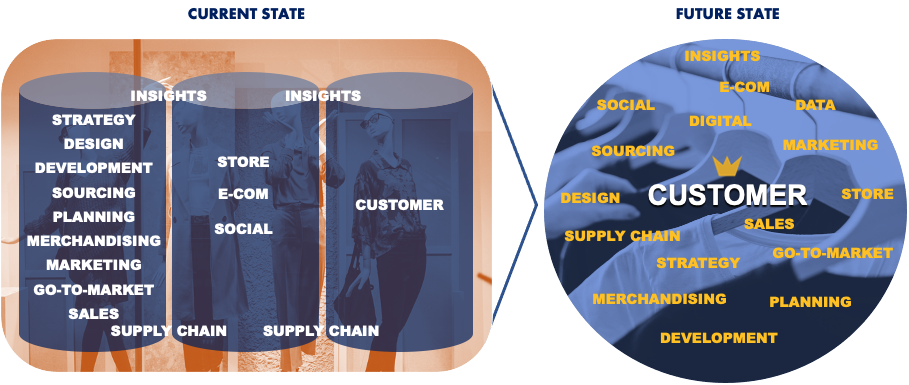Welcome to The Merchant Life, for retailers and retail enthusiasts wanting the insider perspective of all things retail.
Last edition we briefly touched on tearing down silos and putting the customer at the center of the retail universe.
Let’s recap:
Demolishing silos enables collaboration between cross-functional teams – they determine what the customer wants, when they want it, and how they want it.
This way, we become customer obsessed, involving them in product creation, marketing and logistics.
This edition of the newsletter describes WHAT retailers can do to be more customer-centric.
How?
By empowering the customer throughout your end-to-end retail process.
You may want to bookmark this edition as I will be dropping some serious gems today.
Let’s dive in.
If you placed an order for a pair of shoes, would you be willing to wait a year to receive them?
It’s not uncommon for a product to take over a year to go from concept to the shop floor.
Design concepts and strategies are developed well ahead of any jean or sneaker showing up in your browser.
Since retailers plan far in advance, it’s very difficult to make assortment adjustments the more you learn about the customer.
In the 12+ months it takes to design a shoe or dress or pair of jeans, a lot can change.
It becomes difficult to respond to and anticipate change.
For example: A global pandemic could keep you at home for a year while your suits and Loubous gather dust in your unopened closet.
But how do we know that product will really sell? So far ahead?
The big reveal:
We have no idea.
Sales history, ‘gut’ feelings, and current trends serve as a poor foundation upon which to build a forecast.
Formal wear stopped selling, no one wore pants or dresses, and fleece was the fabric of choice. Customer behavior shifted on a dime and planners were singled out with no way to respond as goods were already being produced or in transit on a ship.
The pandemic put planners in the spotlight.
2020 was chaos BUT it left us with the greatest retail tech acceleration of our time.
Predictive analytics, new KPIs from digital engagement, more customer data than ever before, curbside and BOPIS, liveshopping, AI powered solutions that help remove the guesswork, and so much more.
Merchants, planners, and designers are all set.
Well…sort of.
Just having the data is not enough.
This is when art and science mesh with the customer in the middle of the journey.
Here comes the good stuff.
Building in customer validation within product design elicits valuable feedback well before investing in sampling and production.
Infusing feedback into data driven design decisions will hedge the bet that your customers will buy.
For example, you are creating your apparel collection and throughout the design process, you ask your customers questions:
- Tonal OR contrast trim or zipper color?
- Long sleeve OR elbow length sleeve?
- 100% recycled fabrics OR wearable smart textiles / wearable tech?
And so on.
The customer is not only involved in selection but is emotionally invested before the product hits the shop floor.
Meaning they will preferentially choose you over others.
And brand loyalty equates to selling more at full price.
Removing the guesswork when creating product assortments will help you get closer to the customer and get you to market faster.
How can we involve the customer elsewhere?
Market research exists for a reason – to understand what can be improved and why something’s a winner.
…and if you are a marketer reading this, you understand that customer feedback during and after a sale is gold.
If customer feedback is not incorporated into things like fit or filling the gaps in a product mix, then the retailer will lose.
And the customer will jump ship.
Like I did.
For example:
In the last few weeks, I have returned an online order and also shopped in the physical of a global retailer. I was asked to give feedback after both instances and was enticed to do so for a chance to win some retail therapy cash.
I filled out the survey both times and spoke of fit, of alleged stretch in a garment that turned out to have no stretch in real life, and of the pricing inconsistencies across online and in-store promotions.
I took the time to fill out the surveys with no one contacting me to better understand my concerns or tell me that things will change.
Also no payout 🙄
Now imagine if the retailer acted on feedback and actually heard you.
Take this AWESOME example of the co-founder of HUSH BLANKETS, Aaron Spivak:
or this one…
Retailing can be an uphill battle if you don’t truly listen to customers.
If you are getting repeat returns or your product is just not selling, you need to make a change.
Take the feedback and act.
Act like Aaron.
As you plan your store assortments, the evergreen challenge is about how to remain relevant.
To be relevant, you must CURATE, PERSONALIZE, AND LOCALIZE.
As a merchant, I did just that.
At Ralph Lauren, when a new collection hit the floor, I visited as many stores as I could. Flagship doors to the smallest shops, I engaged with sales brand ambassadors, store managers, and most importantly the customers.
Asking questions like:
- Why do you buy Ralph Lauren and how often?
- What’s your favorite fit that we offer?
- What makes you cringe and what should we never put on the shop floor again?
I would help them style and put together outfits to better understand who is actually shopping the collection and how does every product in the collection fit.
I did the same exercise at Club Monaco and when I was a department store buyer. Walking and talking to customers, changing the buys where I would get terrible feedback, and making sure that I listened to the customer when they told me that I didn’t have anything that served them at all.
As we infuse more and more technology to remove manual and redundant tasks, assisted by planners who will have the tools to predict customer demand and behavior, merchants can focus more time WITH the customer.
Art and science meet again, giving the buyer more time to curate assortments to what the customer wants in real time instead of guessing what they could want 12+ months from now.
Getting to know shoppers on the shop floor, talking to them via chat on digital platforms, and understanding them on a deeper level will give you insights that data can’t.
Use art and science to align to the values of your customers.
Be relevant and relatable.
Because being relatable is authentic and will keep your customers coming back.
The Finish Line
The role of the customer has changed from the end of the retail model to the middle.
We also need to consider that involving the customer in validating product will help retailers be more relevant, relatable, and authentic.
Aligning values with your customer will infuse loyalty and more full priced sales.
Give your customer the opportunity to be part of the retail journey.
Make them the center of your retail universe.










